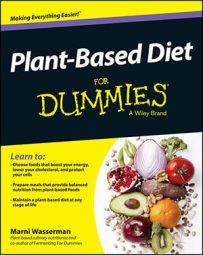A core of foods makes up a plant-based diet. Making sure that you really understand them is key for a strong foundational knowledge that you can continuously build upon. You’ll find so many wonderful foods to explore and try, but for now here are the basics and what foods to avoid.
The big question is, “If I’m not eating anything from an animal, what is there to eat?”
Valuable vegetables
You’ll discover a whole array of veggies that you’ll likely get to know quite well while eating plant-based. If you’re new to this, you’ll probably stick to tried-and-true, familiar veggies in the beginning because they’ll feel safe — and that is A-okay!
But over time, expand into new areas and pick up that funny-looking squash over there or try that wild, leafy bunch of something over here. Here’s a greater starting point:
Beets
Carrots
Kale
Parsley, basil, and other herbs
Spinach
Squash
Sweet potatoes
Fantastic fruits
Ahhh, the sweet juiciness of fresh fruit. If you don’t love fruit, you need to get on this train, because fruits are delicious; sweet; full of fiber, color, and wonderful vitamins; and so, so good for you. Here are some top picks to start with:
Apples
Avocado
Bananas
Blueberries
Coconut
Mango
Pears
Pineapple
Raspberries
Strawberries
Wonderful whole grains
Consuming good-quality whole grains is a healthy part of a plant-based diet. Don’t worry; you can still have your breads and pastas, but “whole” is the key word here. You don’t want refined or processed — you want the real thing.
When you buy these items, make sure the grain itself is the only ingredient. Although it’s possible to buy proper whole grains off the shelf in packaging, make sure you double-check the label to confirm that it is, indeed, a whole grain (and only a whole grain). Here are some favorites:
Brown rice
Brown-rice pasta
Quinoa
Rolled oats
Sprouted-grain spelt bread
Lovable legumes
Learning to love beans on a plant-based diet is key, as they’re a great source of sustenance, protein, and fuel. It may take you and your body a little while to get used to them, but soon enough they’ll be your friends — especially when you discover how great it is to eat them in soups, salads, burgers, and other creative mediums. Here are some of the best to start with:
Black beans
Chickpeas
Kidney beans
Lentils
Split peas
Notable nuts and seeds
Most people love a good handful of nuts! But the thing about eating them on a plant-based diet is making sure that they’re unsalted, un-oiled, and raw. As long as you enjoy them in their natural state, you can feel free to eat them in moderation alongside your other wonderful plant-based foods. Here are the best ones to start with:
Almonds
Cashews
Chia seeds
Flaxseeds
Hempseeds
Pumpkin seeds
Sunflower seeds
Walnuts
Try munching on a few nuts or seeds straight up or adding them to salads or other recipes. And if you can’t decide which one you have a taste for, toss them all in a trail mix!
The extras
This is the category of foods that isn’t really a category, per se, but these foods are still part of the plant-based diet. This includes such things as exotic superfoods, sea vegetables, condiments, and natural sweeteners. Here are some specific examples:
Cacao: The pure form of chocolate
Coconut oil: Raw, virgin unprocessed oil (and the perfect butter substitute)
Honey: The raw stuff, not the kind in bear-shaped plastic bottles
Maple syrup: Again, the real stuff — no corn syrup here!
Nori: A delicious and nutritious sea vegetable
Tamari: A versatile fermented soy sauce
What’s off limits
As you can imagine, all things that aren’t plants are off limits; however, you may need or want a transitional period during which you wean yourself off these foods one at a time until you can avoid all things from the animal world — including meat, poultry, fish, eggs, milk, and other dairy products.
In addition, because this is a clean way of living, you may cut out most processed and fried foods that don’t serve your body and your health on a nutritional level.
Of course, this is the ideal — you have to find your own place on the spectrum of plant-based eating and do what works for you. Often, making something off limits just makes you want it more, so you have to strike the balance between being tough on yourself and being practical.

